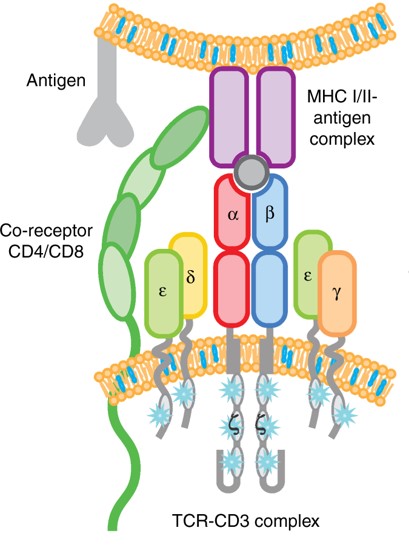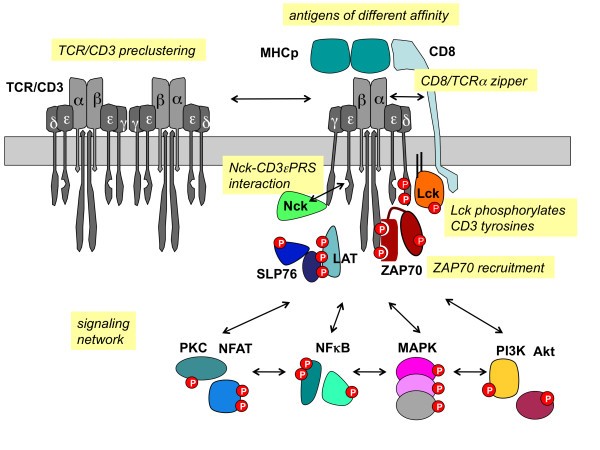Hi-Affi™ hCD3EDG Triple Humanized Mouse Model
CD3 is involved in antigen recognition and intracellular signal transduction through forming the complex with T cell receptor (TCR), and plays an important role in immune response. Antibodies that use CD3 as one of the targets have become a "gold mine" in the development of tumor-targeted therapeutic drugs. Creative Biolabs has successfully established an optimized Hi-Affi™ “humanized” animal platform to offer specialty manipulated hCD3EDG triple humanized mice for our clients all over the world.
hCD3EDG Molecule
Human CD3 (cluster of differentiation 3, hCD3) molecule is an important symbol on the surface of T cells. It acts as a T cell co-receptor, which helps TCR complete the intracellular transmission of the first signal. The hCD3 protein is composed of three pairs of dimers (εγ, εδ, ζζ). These subunits all have an N-terminal extracellular domain, a transmembrane domain, and a cytoplasmic tail. Also, it contains an immunoreceptor tyrosine-based activation motif (ITAM) in the intracellular domain. Among them, CD3ε, CD3γ, and CD3δ are highly homologous, which are encoded by CD3E, CD3G, and CD3D genes, respectively. CD3E, CD3G, and CD3D genes are located on human chromosome q23.
 Fig.1 The structure of the TCR-CD3 complex. (Helsen, 2018)1, 3
Fig.1 The structure of the TCR-CD3 complex. (Helsen, 2018)1, 3
hCD3EDG Signal Pathway
The characteristic sequence of intracellular ITAM is YXXL/I X6-8YXXL/I (where X represents any amino acid residue). ITAMs are necessary to initiate signal cascade reactions because they recruit protein tyrosine kinases, signal transduction intermediates, and adapter molecules. The intracellular domains of CD3ε, CD3γ, and CD3δ all contain one ITAM, while the intracellular domain of CD3ζ contains three ITAMs, producing a total of ten ITAMs, making the TCR/CD3 complex very sensitive to antigen binding. After TCR binding, these ITAM motifs are phosphorylated by Src family protein tyrosine kinases LCK and FYN, leading to the activation of downstream signaling pathways.
After antigen stimulation, the conformational changes in the cytoplasmic tail of the hCD3 polypeptide. Protein tyrosine kinases (PTKs) belongs to the Src family, such as LCK and FYN. They reside in the ITAMs of the CD3 complex to produce the docking location for the proteins with SH2 domains (such as ζ-related proteins ZAP70). After ZAP70 binds to CD3, T cell activation adaptor LAT is phosphorylated, recruiting multiple adaptors and effector molecules (such as SLP76, PLCγ1, etc.). This mediates the activation of downstream signaling pathways, such as calmodulin, MAPK, and NF-κB signaling pathways. This signal pathway is extremely essential for T cell activation and proper T cell development.
 Fig.2 Signal transduction of TCR/CD3. (Louis-Dit-Sully, 2012)2, 3
Fig.2 Signal transduction of TCR/CD3. (Louis-Dit-Sully, 2012)2, 3
Development of hCD3EDG Triple Humanized Mice
Since the first therapeutic monoclonal antibody drug approved by the FDA for marketing is the hCD3 monoclonal antibody (OKT3), whose recognition site is the CD3ε chain, the development of antibody-based on other hCD3 subunits, such as CD3δ and CD3γ has been underway. Creative Biolabs has successfully established an array of well-established Hi-Affi™ “humanized” animal models, including the hCD3EDG triple humanized mice. With advanced facilities, a professional R&D team, and a stringent QC system, we have provided preclinical drug development services for our clients from all over the world for many years. If you have any questions, please feel free to contact us for more details.
Creative Biolabs also offers other various Humanized Mouse Models you may be interested in:
References
- Helsen, C. W.; et al. The chimeric TAC receptor co-opts the T cell receptor yielding robust anti-tumor activity without toxicity. Nat Commun. 2018, 9(1): 3049.
- Louis-Dit-Sully, C.; et al. Meeting report: signal transduction meets systems biology. Cell Commun Signal. 2012, 10(1): 11.
- under Open Access license CC BY 4.0, without modification.
For Research Use Only.
